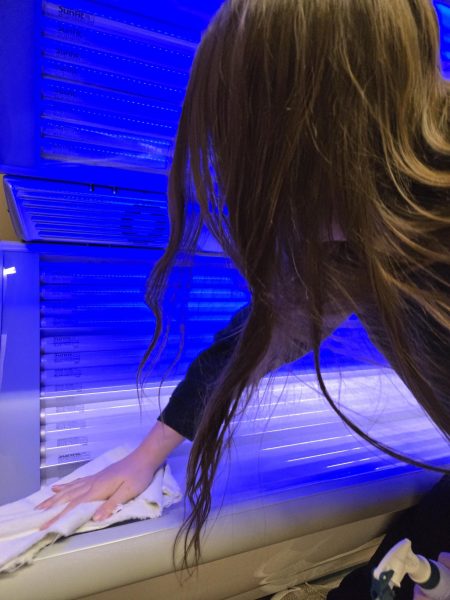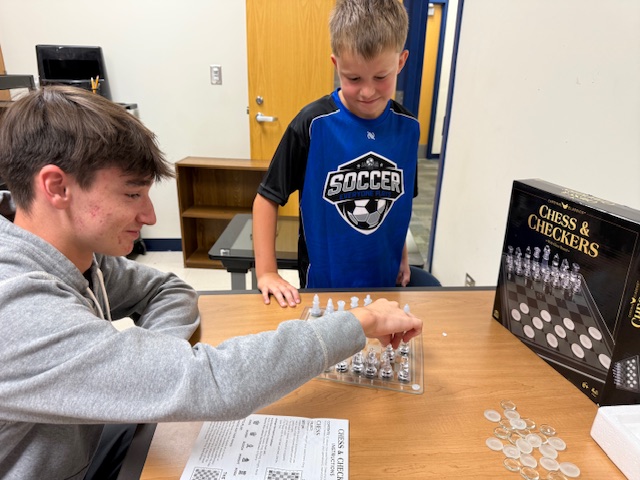When the weather is good, people go outside to enjoy the sunshine. Although the warm sunshine feels great, it can be dangerous. Despite warnings, the American Cancer Society reports that about 104,960 new melanomas will be diagnosed and about 8,430 people are expected to die of melanoma in 2025 (“Melanoma Skin Cancer Statistics”). In an Eye of the Gale questionnaire, some students and staff members said that they either tan outside in the sun, go to tanning beds, or use self-tanning products.

LHS freshman Jezzell Palm said she tans naturally in the sun because the sun feels relaxing.
“I enjoy tanning in the sun sometimes during summertime because I like feeling the warmth, and in my opinion, being just a bit more tan in complexion is better looking on me than the very fair paleness in winter, and it brings out my freckles as well,” said Palm.
LHS freshman Aiyana Adams said she likes tanning in the sunshine because she likes the results.

“I tan in the sun because I like the natural color the sun gives me,” said Adams.
LHS junior Aries Couts said he likes to naturally tan because he does activities outside and tans over time.

“I’m already outdoors a lot during the summer and spring, so I basically just naturally tan over that four to five month period,” he said.
While the natural sun sounds positive, it is deceiving. For decades, officials have warned people about skin cancer – tanning connections. It is well established that the sun’s ultraviolet (UV) radiation is the primary cause of skin cancer. Still, many people seem reluctant to heed the warnings.
In an article by the AIM At Melanoma Foundation, we say that tanning outdoors greatly increases chances of skin cancer, especially if you’re under eighteen.
“Sun damage builds up over time, so even tanning every once in a while can have unintended consequences over the course of your lifetime. Cumulative sun exposure is linked to development of basal cell carcinoma, squamous cell carcinoma, and melanoma. Sunburns—especially blistering sunburns and especially if they occur before age 18—are also linked to the development of melanoma. Melanoma is the most serious form of skin cancer and causes the vast majority of all skin cancer deaths” (“What Are the Dangers of Outdoor Tanning?”).
Those who avoid the sun but use tanning beds may feel that the UV rays from tanning beds are the lesser of two evils. Unfortunately, that is a myth. In fact, using a tanning bed greatly increases a person’s chances of developing skin cancer. In an interview with the Skin Cancer Foundation, Blair Murphy-Rose, MD said that it is surprising that tanning salon businesses are still operational.
“There’s overwhelming evidence that tanning beds are a carcinogen, which means we know they cause cancer. The FDA bans other carcinogens, but somehow tanning is still allowed. Let’s look at some of that evidence: In the United States, almost half a million cases of skin cancer a year are linked to indoor tanning,” he said.
Additionally, the Skin Cancer Foundation reports that even one tanning session is dangerous, especially for young people.

“Research shows that 97 percent of women who are diagnosed with melanoma before the age of 30 had a history of tanning bed use. And there’s a 75 percent increase in risk of developing melanoma if you’ve used a tanning bed before the age of 35. Even one session is dangerous” (“Ask the Expert: Why Is Indoor Tanning Still Legal When We Know It Causes Skin Cancer?”).
LHS senior Shyanne Munday said she uses tanning beds because she feels it is safer than the hot sun.
“I don’t think it’s a good idea, but I still do it anyway because I like to have a darker complexion compared to a lighter appearance. In the winter and spring, the UV is not as strong to give you a tan,” she said.
According to the American Academy of Dermatology Association (AAD), in addition to skin cancer, tanning beds can cause a wide range of injuries to people.
“In emergency rooms across the United States, people are treated for burns, loss of consciousness, and eye injuries caused by indoor tanning. Many people believe that using a tanning bed to get a base tan will prevent sunburn. Absolute myth. If you have a base tan, you can still burn. Every time you tan or burn, you also damage the DNA in your skin. The more you damage your DNA, the greater your risk of getting skin cancer” (“10 Surprising Facts About Indoor Tanning”).
On the other hand, if one desires a summer sun-kissed appearance, medical officials suggest sunless tanning lotions and creams that contain ingredients approved by the Food and Drug Administration (FDA).
“These options are safe and harmless,” according to Chief of dermatology for Kaiser Permanente in sunny San Diego, Jeff Benabio, MD, MBA.
“I often hear from patients who are fair-skinned that they want a little more color. I tell them that using sunless tanning products can help them get a tan without spending time in the sun. This limits their exposure to

harmful ultraviolet (UV) radiation, which accelerates the skin’s aging process and increases the risk for skin cancer,” he said in the article, “Is Sunless Tanning Safe? Here’s What You Need to Know.”
LHS sophomore Charlee McKisson said she uses self-tanning products because she wants to look good on stage during performances.
“I dance, so I don’t want to look washed out by the stage lights,” she said.
Still, to avoid sunburns, skin damage, premature aging, and skin cancer, Kaiser Permanente officials suggest the following precautions when tanning:
- Avoid the sun when possible, especially between 10 a.m. and 4 p.m.
- If one needs to be outside, try to stay in the shade.
- Wear protective gear like a wide-brimmed hat, sunglasses, and clothing that covers arms and legs.
- Apply sunscreen with a sun protection factor (SPF) of at least 30 and reapply it every two hours.








